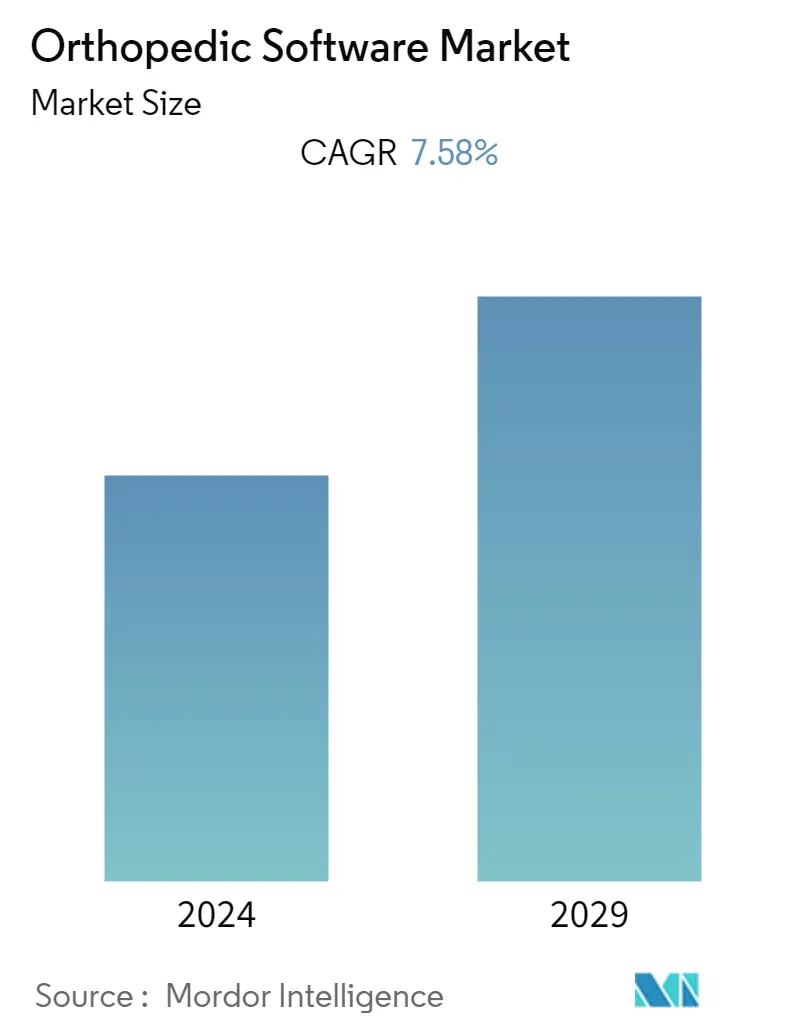Market Size of Orthopedic Software Industry

| Study Period | 2019 - 2029 |
| Base Year For Estimation | 2023 |
| Forecast Data Period | 2024 - 2029 |
| CAGR | 7.58 % |
| Fastest Growing Market | Asia-Pacific |
| Largest Market | North America |
Major Players
*Disclaimer: Major Players sorted in no particular order |
Orthopedic Software Market Analysis
The orthopedic software market is poised to grow at a CAGR of 7.58% over the forecast period.
The emergence of the COVID-19 pandemic impacted the market studied due to declined hospital and ambulatory surgical center visits because of the global lockdown restrictions imposed by the government. Also, in a few regions, the orthopedic and small hospitals were shut down or curtailed their operations and services. Other hospitals were converted to containment facilities and treatment wards for COVID-19 patients, which impacted the market growth. For instance, as per an article published by Orthopedic Surgery in May 2022, it was observed that the average number of elective surgeries, such as hip and knee replacement, decreased by 90%. In addition, as per the same source, the number of new patient visits decreased by 25.5% during the pandemic. However, orthopedic procedures are expected to increase with released restrictions, resumed services, and increased hospital visits. For instance, from an article published in June 2022, it has been found that the demand for key-hole surgeries in the shoulder joint increased by 20% to 40% in 2021. This is expected to fuel the demand for cloud applications and management services, which is anticipated to boost the growth of the orthopedic software market over the forecast period.
Certain factors attributing to the market growth are the increasing orthopedic problems and injuries, a rising aging population, the growing adoption of minimally invasive surgeries, increasing research and development, and rising technological advancements.
The rising number of people suffering from orthopedic problems and injuries is the key factor driving the market growth. For instance, the article published in the National Natural Science Foundation of China (NSFC) in June 2022 stated that the prevalence of knee joint osteoarthritis in China was higher in females than males. Also, from an article published in September 2022, it has been observed that the prevalence of self-reported joint pain or osteoarthritis has increased from 45.3% in 2020 to 54.7% in 2021 in Bangladesh. Thus, the growing burden of orthopedic disorders and associated surgeries is expected to increase the demand for smart software that helps carry out the anatomical assessment, planning, and measurements of the respective structures, such as knees and spines, which helps achieve optimal and revision-safe surgery preparation. This increases the adoption of software and applications in the orthopedic area and is anticipated to fuel market growth over the forecast period.
Additionally, the growing geriatric population across the globe is expected to increase the number of people suffering from orthopedic diseases, such as arthritis, osteoarthritis, and rheumatoid arthritis, as they are more prone to develop joint-related disorders due to weaker bones. For instance, as per an article published in PLOS One, in February 2021, about 50% of the elderly population aged 60 years or above is suffering from osteoarthritis, which limits their ability to engage in physical activity and causes pain and symptoms, such as joint stiffness and swelling, muscle weakness, and restricted range of motion.
Also, as per the data published by the UN in 2022, the number of people aged 65 years or above is expected to more than double globally by 2050, rising from 727 million in 2020 to 1.5 billion in 2050. Thus, the growing aging population is expected to increase the number of orthopedic problems and hospital visits for diagnosis, treatment, and surgeries. This is anticipated to augment the demand for advanced software that shows up the 3D structure of the bone and helps in accurate diagnosis and surgeries, thereby boosting the market growth.
Furthermore, the rising awareness regarding osteoporosis and other orthopedic disorders among the population is anticipated to increase the need for orthopedic EHR, templating, and preoperative planning software, which is expected to fuel the market growth over the forecast period. For instance, in Europe, the International Osteoporosis Foundation (IOF) is responsible for raising awareness of osteoporosis care. As per the report published by IOF in 2021, more than 23 million men and women are at high risk of osteoporotic fractures in the European Union.
Moreover, the rising company activities in launching software and cloud systems contribute to market growth. For instance, in August 2021, OrthoGrid Systems Inc. launched a new OrthoGrid Trauma Application, the latest application of OrthoGrid's Surgical Digital Platform. Also, in January 2021, Ortoma AB launched an artificial intelligence-based software platform, OTS 5, to improve surgical accuracy. The platform has been developed for surgical instruments and includes many improvements to existing functionalities and various new ones. The latest version enhances usability before and after surgery and consists of an Ortoma Plan and Ortoma Guide.
However, the absence of healthcare insurance in emerging economies and the lack of skilled professionals are some factors impeding the market growth over the forecast period.
Orthopedic Software Industry Segmentation
As per the scope of the report, orthopedic software deals with a large amount of data from lab test results, including imaging during diagnosis and follow-up charts of the patient during recovery. The orthopedic software market is segmented by Product (Digital Templating/Preoperative Planning Software, Orthopedic Electronic Health Record (EHR), Orthopedic Practice Management, Orthopedic Picture Archiving, and Communication Systems (PACS), Orthopedic Revenue Cycle Management, Other Equipment, and Systems), Mode of Delivery (Cloud/Web Based and On-premise), Application (Orthopedic Surgery, Fracture Management, and Other Applications), and Geography (North America, Europe, Asia-Pacific, Middle-East and Africa and South America). The market report also covers the estimated market sizes and trends for 17 different countries across major regions globally. The report offers the value (USD million) for the above segments.
| By Product Type | |
| Digital Templating/Preoperative Planning Software | |
| Orthopedic Electronic Health Record (EHR) | |
| Orthopedic Practice Management | |
| Orthopedic Picture Archiving and Communication Systems (PACS) | |
| Orthopedic Revenue Cycle Management | |
| Other Equipment and Systems |
| By Mode of Delivery | |
| Cloud/Web Based | |
| On-premise |
| By Application | |
| Orthopedic Surgery | |
| Fracture Management | |
| Other Applications |
| Geography | ||||||||
| ||||||||
| ||||||||
| ||||||||
| ||||||||
|
Orthopedic Software Market Size Summary
The orthopedic software market is set to experience significant growth over the forecast period, driven by several key factors. The increasing prevalence of orthopedic disorders, such as arthritis and osteoarthritis, particularly among the aging population, is a major contributor to this growth. As the global population ages, the demand for advanced orthopedic software that facilitates accurate diagnosis and surgery planning is expected to rise. The market is also benefiting from the growing adoption of minimally invasive surgeries and technological advancements in software applications. Despite the initial setbacks caused by the COVID-19 pandemic, which led to a decline in elective surgeries and hospital visits, the market is rebounding as restrictions are lifted and healthcare services resume. The demand for cloud-based applications and management services is anticipated to further boost market expansion.
North America is projected to dominate the orthopedic software market due to its well-developed healthcare infrastructure and the rising prevalence of orthopedic disorders in the region. The increasing number of elderly individuals suffering from joint-related issues is driving the demand for non-surgical procedures and advanced software solutions. Companies are actively engaging in mergers, acquisitions, and the launch of new products to enhance their market presence and product offerings. Key players in the market, such as Brainlab AG, GE Healthcare, and IBM Corporation, are focusing on developing innovative software solutions to meet the growing needs of orthopedic providers. The market's growth is also supported by the rising awareness of orthopedic disorders and the need for electronic health records and preoperative planning software, which are expected to see significant adoption in the coming years.
Orthopedic Software Market Size - Table of Contents
-
1. MARKET DYNAMICS
-
1.1 Market Overview
-
1.2 Market Drivers
-
1.2.1 Rising Aging Population and Increasing Orthopedic Problems and Injuries
-
1.2.2 Increasing Adoption of Minimal Invasive Surgeries
-
1.2.3 Growing R&D and Technological Advancements
-
-
1.3 Market Restraints
-
1.3.1 Absence of Healthcare Insurances in the Emerging Economies
-
1.3.2 Lack of Skilled Professionals
-
-
1.4 Porter's Five Force Analysis
-
1.4.1 Threat of New Entrants
-
1.4.2 Bargaining Power of Buyers/Consumers
-
1.4.3 Bargaining Power of Suppliers
-
1.4.4 Threat of Substitute Products
-
1.4.5 Intensity of Competitive Rivalry
-
-
-
2. MARKET SEGMENTATION (Market Size by Value - USD million)
-
2.1 By Product Type
-
2.1.1 Digital Templating/Preoperative Planning Software
-
2.1.2 Orthopedic Electronic Health Record (EHR)
-
2.1.3 Orthopedic Practice Management
-
2.1.4 Orthopedic Picture Archiving and Communication Systems (PACS)
-
2.1.5 Orthopedic Revenue Cycle Management
-
2.1.6 Other Equipment and Systems
-
-
2.2 By Mode of Delivery
-
2.2.1 Cloud/Web Based
-
2.2.2 On-premise
-
-
2.3 By Application
-
2.3.1 Orthopedic Surgery
-
2.3.2 Fracture Management
-
2.3.3 Other Applications
-
-
2.4 Geography
-
2.4.1 North America
-
2.4.1.1 United States
-
2.4.1.2 Canada
-
2.4.1.3 Mexico
-
-
2.4.2 Europe
-
2.4.2.1 Germany
-
2.4.2.2 United Kingdom
-
2.4.2.3 France
-
2.4.2.4 Italy
-
2.4.2.5 Spain
-
2.4.2.6 Rest of Europe
-
-
2.4.3 Asia-Pacific
-
2.4.3.1 China
-
2.4.3.2 Japan
-
2.4.3.3 India
-
2.4.3.4 Australia
-
2.4.3.5 South Korea
-
2.4.3.6 Rest of Asia-Pacific
-
-
2.4.4 Middle East and Africa
-
2.4.4.1 GCC
-
2.4.4.2 South Africa
-
2.4.4.3 Rest of Middle East and Africa
-
-
2.4.5 South America
-
2.4.5.1 Brazil
-
2.4.5.2 Argentina
-
2.4.5.3 Rest of South America
-
-
-
Orthopedic Software Market Size FAQs
What is the current Orthopedic Software Market size?
The Orthopedic Software Market is projected to register a CAGR of 7.58% during the forecast period (2024-2029)
Who are the key players in Orthopedic Software Market?
Brainlab AG, Materialise NV, GE Healthcare, Medstrat Inc. and IBM Corporation (Merge Healthcare Inc.) are the major companies operating in the Orthopedic Software Market.

